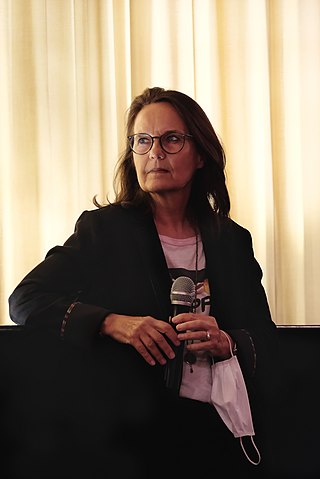
The Silence of the Lambs is a 1991 American psychological horror thriller film directed by Jonathan Demme and written by Ted Tally, adapted from Thomas Harris's 1988 novel. It stars Jodie Foster as Clarice Starling, a young FBI trainee who is hunting a serial killer named "Buffalo Bill", who skins his female victims. To catch him, she seeks the advice of the imprisoned Hannibal Lecter, a brilliant psychiatrist and cannibalistic serial killer. The film also features performances from Scott Glenn, Anthony Heald, and Kasi Lemmons.
The right to silence is a legal principle which guarantees any individual the right to refuse to answer questions from law enforcement officers or court officials. It is a legal right recognized, explicitly or by convention, in many of the world's legal systems.

4′33″ is a modernist composition by American experimental composer John Cage. It was composed in 1952 for any instrument or combination of instruments; the score instructs performers not to play their instruments throughout the three movements. It is divided into three movements, lasting 30 seconds, two minutes and 23 seconds, and one minute and 40 seconds, respectively, although Cage later stated that the movements' durations can be determined by the musician. As suggested by the title, the composition lasts four minutes and 33 seconds. It is marked by silence except for ambient sound, which is intended to contribute to the performance.

Silence is the absence of ambient audible sound, the emission of sounds of such low intensity that they do not draw attention to themselves, or the state of having ceased to produce sounds; this latter sense can be extended to apply to the cessation or absence of any form of communication, whether through speech or other medium. Remaining mute can be a symptom of mental illness.

"The Sound of Silence" is a song by the American folk rock duo Simon & Garfunkel, written by Paul Simon. The duo's studio audition of the song led to a record deal with Columbia Records, and the original acoustic version was recorded in March 1964 at Columbia's 7th Avenue Recording Studios in New York City for their debut album, Wednesday Morning, 3 A.M., released that October to disappointing sales. An overdubbed electric remix was released the following year and went to number one on the Billboard singles chart.

Matt Bettinelli-Olpin is an American director, writer, actor, and musician. He is a founding member of the punk band Link 80 and co-creator of the filmmaking collectives Chad, Matt & Rob and Radio Silence. He is best known for his work in horror films, including V/H/S, Southbound, Ready or Not, Scream, Scream VI and Abigail.

"Enjoy the Silence" is a song by the English electronic music band Depeche Mode. Recorded in 1989, it was released as the second single from their seventh studio album, Violator (1990), on 5 February 1990. The song is certified Gold in the US and Germany. The song won Best British Single at the Brit Awards 1991.

"Silence" is a song by Canadian electronic music group Delerium featuring Canadian singer and co-writer Sarah McLachlan, first released as a single in May 1999. Over the years, its remixes have been hailed as one of the greatest trance songs of all time, over two decades after its initial release. The Tiësto remix of the song was voted by Mixmag readers as the 12th-greatest dance record of all time.
Silence is the lack of audible sound.

Caroline Link is a German TV and film director and screenwriter.
The Silence of the Lambs or Silence of the Lamb may refer to:

Echoes, Silence, Patience & Grace is the sixth studio album by American rock band Foo Fighters, released on September 25, 2007, through Roswell and RCA Records. The album is noted for a blend of regular rock and acoustic tracks with shifting dynamics, which emerged from the variety of styles employed on the demos the band produced. It also marks the second time the band worked with producer Gil Norton, whom frontman Dave Grohl brought to fully explore the potential of his compositions and have a record that sounded different from their previous work. Grohl tried to focus on songs with messages that resonated with his audience, writing reflective lyrics that drew inspiration from the birth of his daughter.
Conspiracy of silence may refer to:

Suicide Silence is an American deathcore band from Riverside, California. The band was established in 2002, and has released seven studio albums, three EPs, and nineteen music videos. They were awarded the Revolver Golden God award for "Best New Talent" in 2009. The group currently consists of guitarists Chris Garza and Mark Heylmun, bassist Dan Kenny, vocalist Hernan "Eddie" Hermida and drummer Ernie Iniguez.
Breaking the Silence may refer to:
Silence Day or Day of Silence may refer to:

Mitchell Adam Lucker was an American musician best known as the lead vocalist for the deathcore band Suicide Silence.

Silence is a 2016 epic historical drama film directed by Martin Scorsese from a screenplay by Jay Cocks and Scorsese, based on the 1966 novel of the same name by Shūsaku Endō, marking the third filmed adaptation of the novel. The film stars Andrew Garfield, Adam Driver, Tadanobu Asano, Ciarán Hinds and Liam Neeson. The plot follows two 17th-century Jesuit priests who travel from Portugal to Edo period Japan via Macau to locate their missing mentor and spread Catholic Christianity. The story is set in a time when it was common for the faith's Japanese adherents to hide from the persecution that resulted from the suppression of Christianity in Japan after the Shimabara Rebellion (1637–1638) against the Tokugawa shogunate. These are now called the Kakure Kirishitan, or "hidden Christians".

You Can't Stop Me is the fourth studio album by American deathcore band Suicide Silence. It was released in the UK on July 14, 2014 and in North America on July 15 by Nuclear Blast. It is the first album featuring vocalist Hernan "Eddie" Hermida, and the first album without original lead vocalist Mitch Lucker, who died in 2012.
Cone of silence may refer to:
This page is based on this
Wikipedia article Text is available under the
CC BY-SA 4.0 license; additional terms may apply.
Images, videos and audio are available under their respective licenses.












